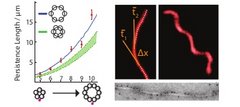Wednesday, 07 August, 2013
Mechanical Properties of DNA Nanotubes
Because of their micrometer scale length and nanometer scale diameter, DNA nanotubes mechanically behave very similar to the molecular filaments that form the cytoskeleton in living cells. In recent years researches have developed several strategies to construct DNA nanotubes of various shapes and sizes and decorate them with functional materials such as fluorescent silver clusters or gold nanoparticles.
Thus DNA nanotubes are great model systems for the mechanical properties of biological filaments and are highly promising for the construction of complex functional materials.
In an international collaboration, a team of researchers (Daniel Schiffels, Tim Liedl (both LMU) and Deborah Fygenson (University of California Santa Barbara) studied the relations between the nanometer scale structure and micrometer scale stiffness of DNA nanotubes.
The laboratory of Prof. Tim Liedl, which focuses on design, construction and functionalization of DNA origami structures developed a technique to attach tiny (5 nm) gold nanoparticles (AuNP) to the outside of DNA nanotubes. Because electrons are heavily scattered on gold particles, they acted as contrast enhancers for the visualization of DNA nanotube twist, which is typically not resolvable by any high resolution imaging technique.
Long-range (micrometer scale) thermal deformations were imaged in real time by fluorescence microscopy in the laboratory of Prof. Fygenson. Daniel Schiffels, first author of the article, which was published in ACS Nano describes the results: Surprisingly we found that DNA nanotubes are very easily twisted, but hard to bend. The authors show that this unusual behaviour can be understood in terms of an elasticity model. Their model takes into account the flexibility of the DNA double helices themselves, as well as that of the single-stranded cross-overs between them.
Schiffels explains: Our work shows that not only the shape, but also the mechanical properties of DNA nanostructures can be rationally designed.
Publication "Nanoscale Structure and Microscale Stiffness of DNA Nanotubes"


